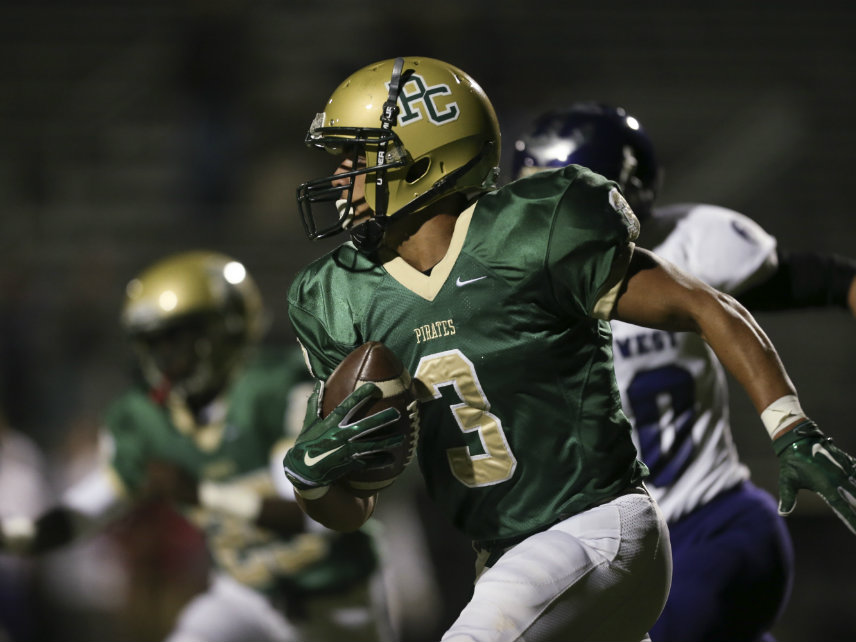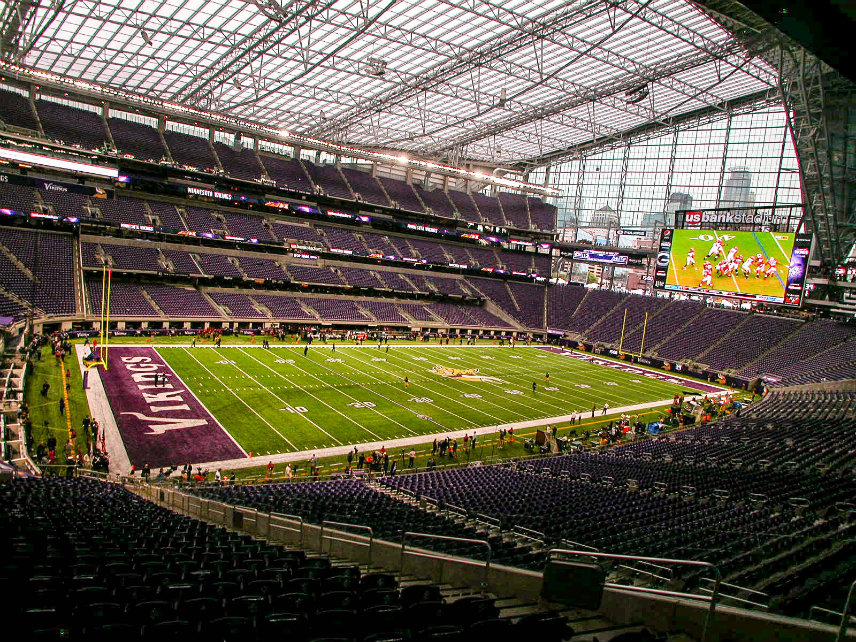Stop Subsidizing Football
Taxpayers shouldn't be supporting a sport that's giving kids brain damage and shouldn't build stadiums for billionaire NFL owners either.

In the sprawling suburbs west of Houston, the newest coliseum to America's favorite sport hosted its first game last week.
Legacy Stadium seats more than 12,000 people in two decks of bleachers that wrap around the side of a gridiron. An HD video board for replays of the action cost $2 million by itself. The final price tag for the whole project was more than $70 million. The most surprising thing of all, perhaps, is that it's not a professional stadium. It's not a college stadium either.
It's the most expensive high school football field in the nation, and it was paid for—every last dime—by the taxpayers of the Katy Independent School District, who approved the stadium as part of a bond package in 2014.
Football is big business in America—from youth and high school levels all the way up to the pros in the National Football League—but the sport benefits from taxpayer subsidies at every level. State and local governments have spent billions of dollars in recent years to build stadiums for pro teams with billionaire owners, and untold millions on stadiums for high school and college teams too. Not all subsidies are so obvious, though, and the feeder system for the NFL relies on a system of high school and college programs that are built largely on the backs of taxpayers.
Taxpayers should not have to support recreational activities of any kind—whether the participants are 17-years-old or earning $17 million a year (an amount some top quarterbacks and wide receivers can command in the NFL)—but they certainly should not be supporting a recreational pursuit that is proven to put young men at risk of serious health problems. There is no longer much doubt that football does that. Just a month before the new Legacy Stadium opened, the most damning evidence linking football to brain damage was published by a researcher at Boston University.
Dr. Ann McKee, a neuropathologist, and a team of researchers at Boston University examined the brains of 111 former NFL players, and found 110 of them had signs of chronic traumatic encephalopathy, or C.T.E., a degenerative brain disease thought to be caused by repetitive head trauma. It can affect "behavior, mood, and cognitive symptoms" and can cause dementia, according to the researchers.
Now that we know more about the health consequences of playing football, there's an urgent need to reassess the role that governments play in propping up a sport that, even though it remains wildly popular, is undoubtedly causing real harm to many of the young men who play it.
School districts should stop subsiding brain damage in the name of athletics.
--
The new NFL season will begin Thursday night at Gillette Stadium in Foxboro, Massachusetts, when the defending Super Bowl champion New England Patriots host the Kansas City Chiefs. The season is scheduled to end on the first Sunday in February 2018 at U.S. Bank Stadium in Minneapolis, the newly built home of the Minnesota Vikings, with the playing of Super Bowl 52.

The two locales are a study in contrasts for how Americans subsidize football. Gillette Stadium opened in 2002 and cost about $412 million. The $325 million stadium was built entirely with private money, financed by Patriot's owner Robert Kraft, while the state of Massachusetts kicked in about $72 million for pay for infrastructure upgrades necessary for the construction and operation of the Patriots' home.
In Minneapolis, local and state taxpayers got soaked for more than $500 million of the $1.1 billion price tag on the Vikings new home, which opened last season. Voters didn't get a referendum on whether they wanted to help team owner Zygi Wilf (estimated net worth: $5.3 billion) pay for the stadium, and the local officials who did vote on the new plan got special access to luxury box seats for all events hosted there.
Gregg Easterbook, author of The King of Sports: Football's Impact on America and a longtime critic of taxpayer subsidies for the sport, says taxpayers have covered more than 70 percent of the total cost of NFL stadiums built in the past two decades. There, the tide may be turning. Officials in Oakland, San Diego, and St. Louis have held the line against demands for new, publicly funded stadiums and have watched professional teams leave town in recent years.
Stadium construction costs are the most expensive, most egregious way that taxpayers are forced to subsidize football, but others have also come under scrutiny in recent years. One of the biggest backdoor subsidies for football—the special loophole in the federal tax code that allowed the National Football League, but not any of its smaller competitors, to avoid federal taxes—was eliminated in 2015. A U.S. Senate investigation in 2015 revealed that the Pentagon had paid $5.4 million to NFL teams for so-called "displays of patriotism" during games between 2011 and 2014.
Professional football could survive without those subsidies. Billionaire team owners could afford to pay for their own stadiums—like the Patriot's Robert Kraft did—and other subsidies like the Pentagon's patriotism theater are little more than a rounding error in the NFL's annual revenue stream.
High school football, though, likely would struggle to survive without taxpayer support. Unlike baseball, which relies in part on a system of private youth baseball programs ranging from Little League to American Legion-sponsored teams for older players, or basketball, in which promising young players often play on Amatuer Athletic Union (AAU) teams, football is inextricably tied to America's public school system. That is largely because of the size of teams required for the sport and because of the more expensive overhead in terms of equipment and, increasingly, insurance costs.
How much do taxpayers across America pay each year to support high school football? There is no definitive figure, but Easterbrook, perhaps the foremost authority on the ways in which the public subsidizes football, estimates that the total could be as high as $10 billion.
"If there are 20,000 public and private high schools of which 95% field football teams with a marginal cost of $100,000 per team per season, that's $1.9 billion per year for high school football -- plus insurance, a number that's rising fast," Easterbrook wrote in an email to Reason this week. "Add tax subsidies to the private prep schools that exist on the dole, and $3 billion per annum seems reasonable. Add lifetime health harm to teens and educational harm to the 98% of players who receiving no recruiting boost to college (1 in 50 prep player gets a college boost), then poor educational results for the many thousands are distracted from the classroom and don't reach college as a result, and high school football soars into the $5 billion to $10 billion harm per year."
At a time when there is rising skepticism about whether the NFL should continue to be subsidized by taxpayers, that spending deserves scrutiny too. (This doesn't even account for college football, which operates on an entirely different—though also often heavily subsidized—model, depending on the size of the school and the value of its football team.)
If you subsidize something, you get more of it, but even $5 billion to $10 billion annually may not be enough to save football at the high school level.
McKee's research at Boston College is the most damning link yet revealed between playing football and CTE. While 110 out of 111 former NFL brains had evidence of CTE, her research also looked at brains of football players who didn't make it to the NFL, with equally scary results.
Researchers found evidence of CTE in 88 percent of the 202 deceased former football players' brains reviewed for the study, which was published last month in the Journal of the American Medical Association. Three out of 14 who had played only in high school had CTE, while 48 out of 53 college players had the disease.
Even before the newest research was made public, U.S.A. Football, a national governing body for youth football, seemed to acknowledge the link. In January, the organization issued new guidelines for how kids should play the sport, emphasizing safety by having younger children play flag football instead of the full-contact version.
That decline is starting to trickle up to high school.
The National Federation of State High School Associations reports that enrollment in high school football dropped by more than 25,000 between the 2015-16 school year and the 2016-17 school year, even as the overall enrollment in high school sports reached record highs last year.
Although it remains the most popular high school sport for boys, football's decline looks practically inevitable as risk-averse parents become more aware of the medical risks associated with the game and it becomes more expensive for schools to insure the players on the field. The numbers are bleaker for youth football programs, which have seen a 30 percent drop in the number of players since 2008, according to the Sports and Fitness Industry Association.
The decline is concentrated at schools in the Midwest and Northeast, which "are shedding high school football programs at a significant rate," The Washington Post reported this month. In just five years, 57 schools in Michigan have dropped the sport. Missouri has lost 24 high school football teams, while Pennsylvania has lost 12. Still, football's popularity is only growing in the South and West, where the number of teams has actually increased in recent years.
Sports can be an important component of childhood development. In an era when children and teenagers are less likely to leave home for recreational activities and when parents are ready to swoop-in at the slightest suggestion of any danger, organized sports league remain critical to the physical development of young bodies and minds.
And in places like Texas, Florida, Ohio, Pennsylvania, and elsewhere, high school football helps bind communities together. Even that $70 million stadium in Katy, Texas, is about more than just football.
"I see it as an instructional facility where you have athletes competing for sure, but you have our bands, cheerleaders and drill teams performing," Lance Hindt, superintendent of the Katy Independent School District, told the Houston Business Journal earlier this year. "In fact, there are more fine arts kids who will perform there than football players. Our telecommunications students will be operating the digital video board."
It certainly makes sense for the district to get as much use as possible out of a $70 million investment, but it's still hard to see a stadium like that getting built without football. Even if a fair bit of the annual subsidies for football are sunk costs—stadiums, sure, but also teachers doubling as coaches, or other athletic resources like locker rooms that would be used by other teams even if football went away—taxpayers should question whether public schools should be supporting a sport that causes serious health problems and has a shrinking population of players.
Even if high school football ended, Easterbrook says, there would be still be plenty of young men willing to risk their health for the chance at fame, glory, and a big paycheck in the NFL. But it wouldn't be the same. "The difference without high school football would be that the many millions of parents, relatives and friends who today attend prep games—far more Americans actually attend high school football than NFL contests—wouldn't go, and wouldn't think of football as something important to their communities."
"That," he says, "would clobber the NFL."


Show Comments (60)